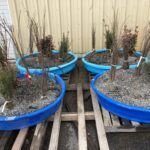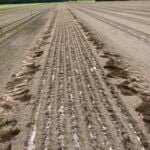Five things to know about the PMC for May 27, 2021
Record sales achieved
The WACD Plant Materials Center 2020-21 sales and shipping season is over! It is too late for planting bare root seedlings.
Final sales figures for this year have been determined and it looks like it has been the best year ever for PMC plant sales. As of May 24, 2021, PMC plant sales stood at $1,162,885 for the year, which is 106% of the sales budget of $1,100,900, and exceeds last year’s sales record of $1,127,415.
It has been pleasantly surprising to see all of the planting projects that have gone on in spite of the pandemic. There was concern that it would either cause our customers to reduce planting or that the PMC would get shut down if COVID spread in the workplace. Fortunately planting continued, but it does cause one to wonder what sales would have been without the pandemic.
A breakdown of sales shows that over 1.5 million plants were sold. Out of that, $670,000 were deciduous hardwood trees and shrubs, $181,300 were conifers, and $206,700 were live stakes. Total sales were comprised of 559 orders to 344 customers. Income from conservation districts constituted 23% of the total and other customers accounted for the remaining 77%.
It has taken the support, commitment, and hard work of a wide array of conservation district supervisors and staff, WACD leadership, customers from diverse backgrounds, and PMC staff and crew to get through this and make it happen. Too many to mention but we know who you are and your efforts are appreciated. Thank you.
Gravel beds

As noted above, bare root season ends by early May because planting bare root later than that is generally unadvisable. The PMC has been looking at ways to extend the bare root planting window, and is in the second year of trying gravel beds.
PMC Assistant Manager John Knox came upon some research where bare root trees and shrubs were healed in pea gravel beds after the season was over and were able to successfully pull them out of the gravel during the growing season and planting them. The theory is that as the roots encounter the gravel and large pore spaces, they branch creating a more fibrous root system that is able to better take up moisture and nutrients. The hope is that this increased capacity will be enough to keep the plant alive after planting out.
Last year’s evaluation looked at several species that were pulled from the gravel beds at different stages during the growing season and planted at the PMC in irrigated ground. Most survived and are vigorously growing now. Some were pulled in the fall and planted on a restoration site. Most of those survived. This year’s trials will include additional species along with planting on restoration sites during the growing season without supplemental irrigation.
Conifer seed planting
The seedbed for the 2022-23 conifer crop has been planted. It appeared to go well but germination will prove to be the final judgment.

The seedbed is composed of almost 4 linear miles of 8-row seedbed, or 32 miles long if it was a single row bed. The bed includes Douglas Fir, Grand Fir, Ponderosa Pine, Shore Pine, Sitka Spruce, Port Orford Cedar, and Incense Cedar. All of these species have seeds with wings which improves seed dispersal from the parent trees. Most of these seeds are able to be dewinged for easier and more accurate planting.

The one exception – and there is always an exception! – is Incense Cedar. Its wing is an integral part of the seed coat and if it is dewinged the seed dies. Those seeds have to be hand planted since they will not go through the seed drill. There is more than enough demand so the PMC goes back to the basics and hand plants them which gives us a deeper understanding of what it was like to farm in 3,000 BC.
Another aspect of the conifer seedbed is that most of the species listed above include seed lots from multiple seed transfer zones. The PMC gets seed from different geographic regions of the northwest with the intention of providing more site-specific seedlings for customers throughout the region. Trees from a specific region have adapted to its climate and weather and the resulting seedlings perform better when planted in similar conditions.
Upcoming 2021-2022 sales season
With the 2020-21 sales season behind us, it is time to turn our attention to the 2021-22 sales season (no rest for the wicked). Anyone that knows of plant materials needs for next year is encouraged to place their order sooner rather than later to ensure that they get what they want. There are always several species that are sold out before harvest begins. Let us know if we can help in any way.
On a side note, our new Sales Manager Jacquie Gauthier will start on June 7th and she would be happy to get to know you, your needs, and find out how we can help.
Coming up
Spring seed planting for the hardwood, deciduous species follows conifer seed planting. The seed has been in cold, moist seed stratification for a period of weeks or months. It is now drying so it can pass through the seed drill properly.
Most of the hardwood, deciduous species are planted in the fall. They undergo a natural stratification process by being exposed to cold, wet conditions all winter, followed by germinating in the spring. Fall sowing does not work for some species, however. Blue Elderberry is one example of a species that does not work with fall sowing, possibly due to insufficient cold temperatures here in winter. When they are stratified in a refrigerator, they remain at 34° F and never experience periods in the 40°’s and 50°’s.
Seeds of some species require light in order to germinate and if they are covered with soil, they will not come up. These include the Alders, Birch’s, Mock Orange, Spirea, Oceanspray, Cottonwood, and Aspen. They are sown on top of the soil and are irrigated so that they remain moist enough to adhere to the ground. They are therefore planted in the spring when they can germinate and start growing within a reasonable amount of time. It is not a practice for the faint of heart.
I hope this helps. Please let me know if you have any questions.
Jim Brown, WACD PMC Nursery Manager
https://wacdpmc.org/about-us
